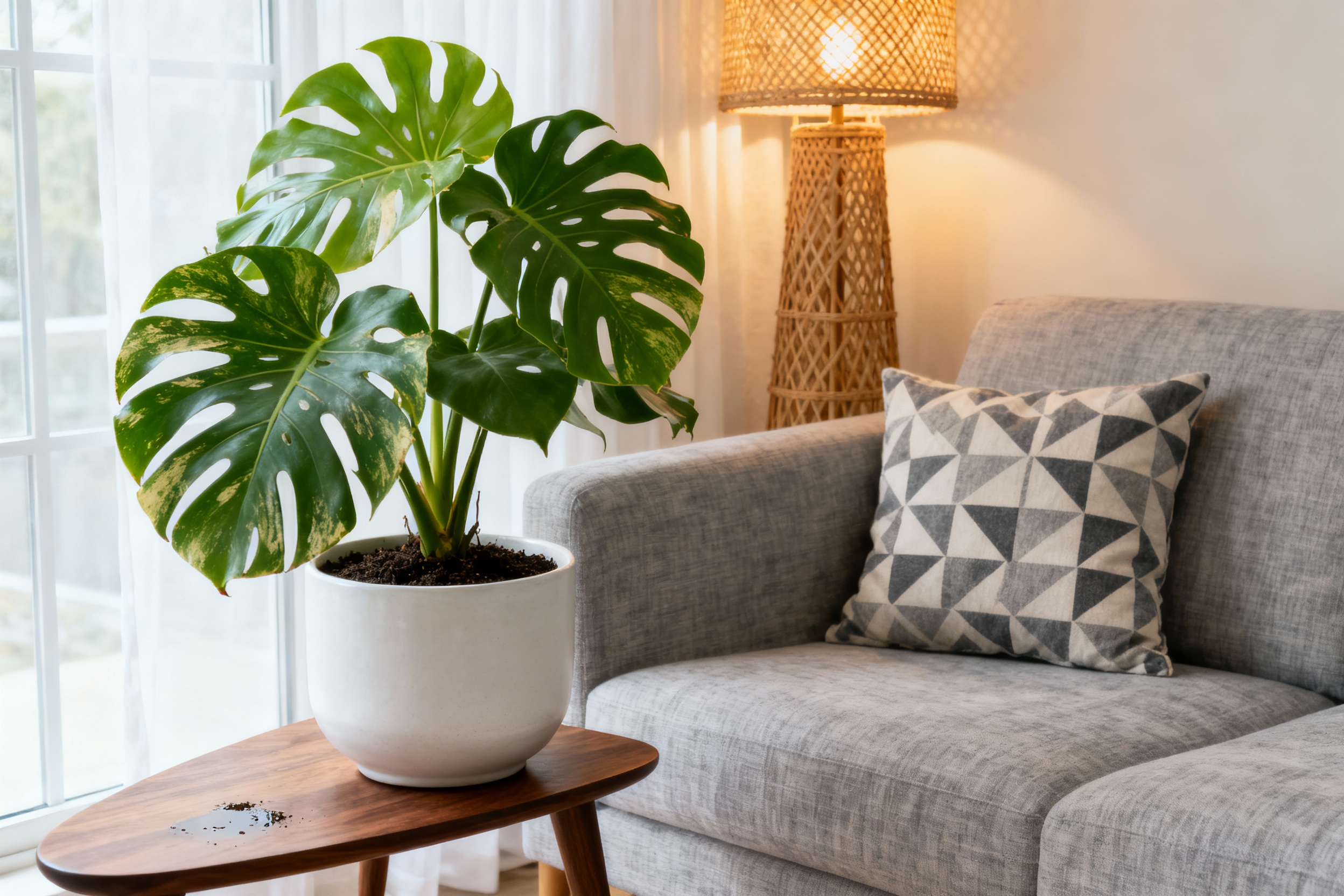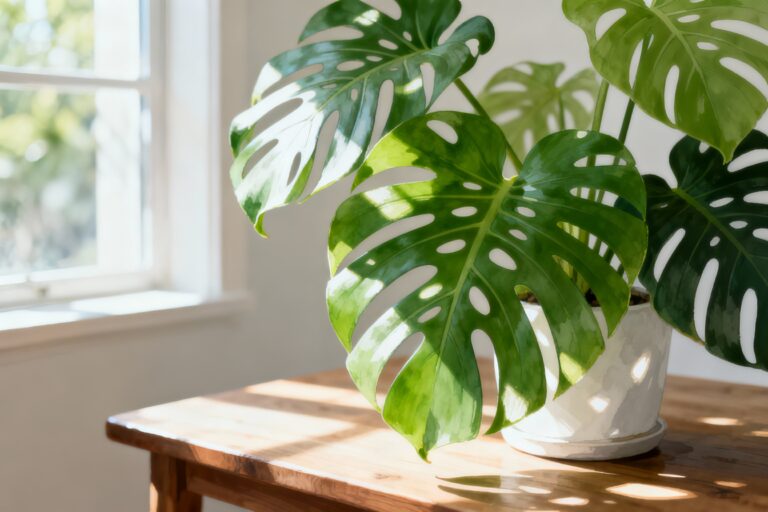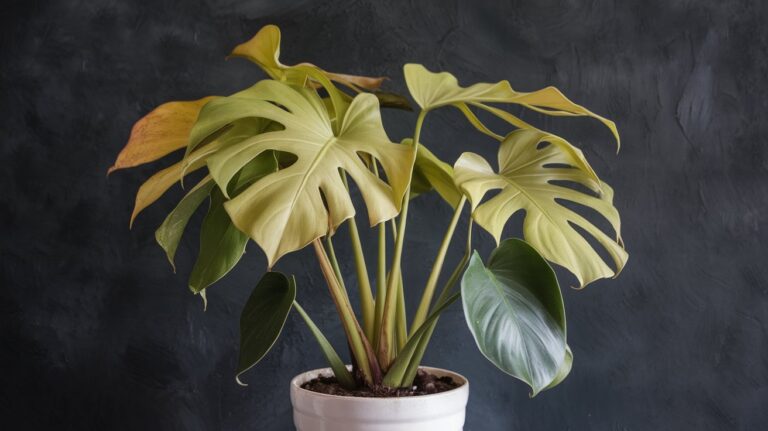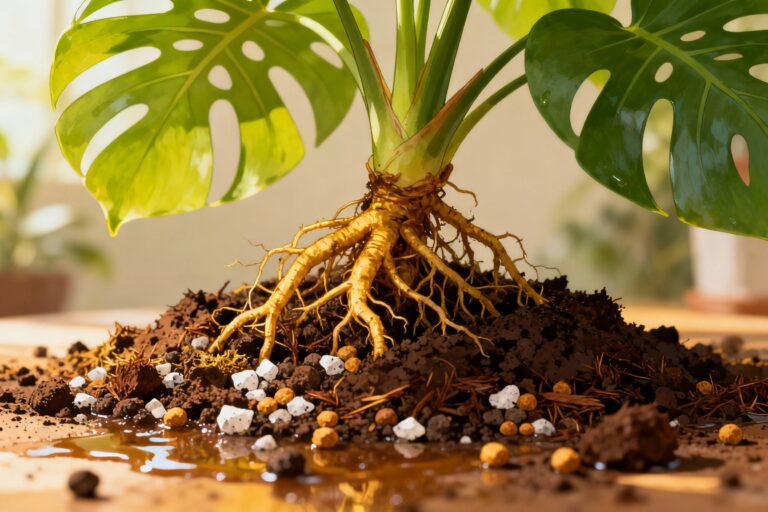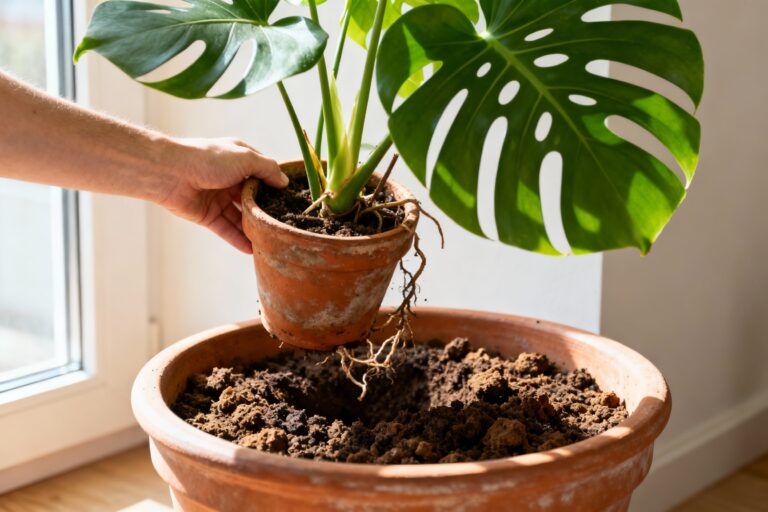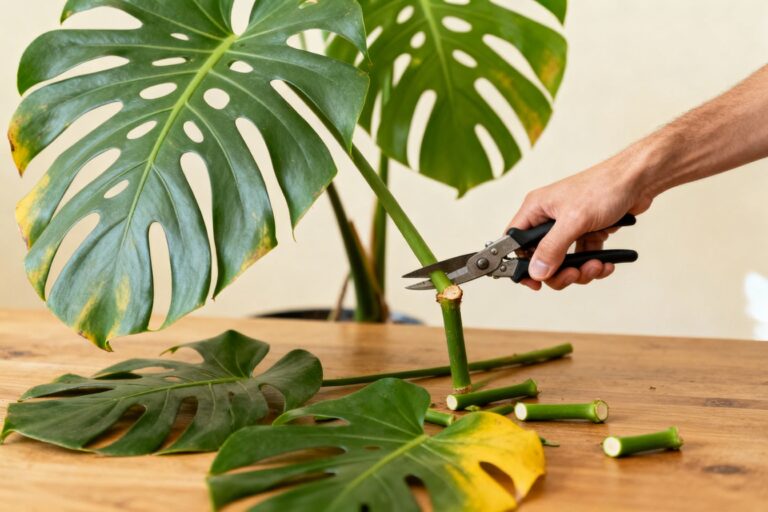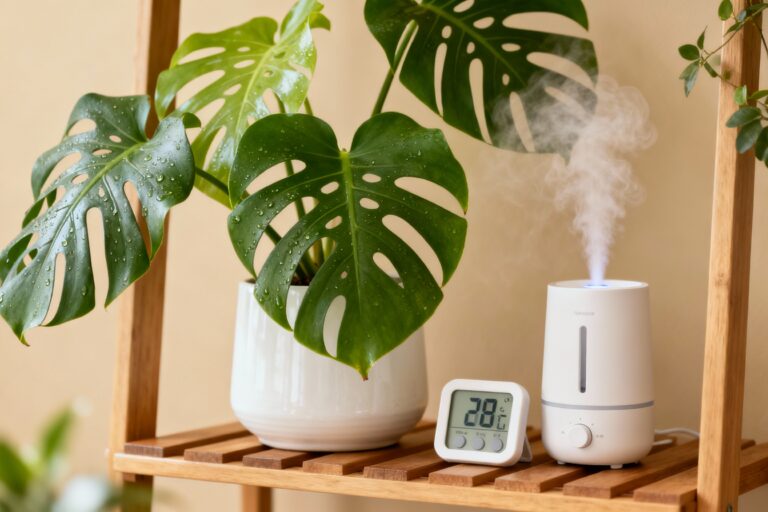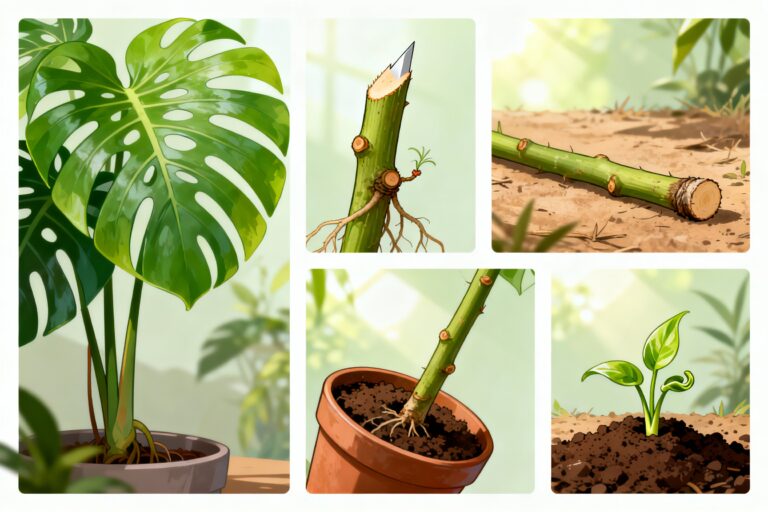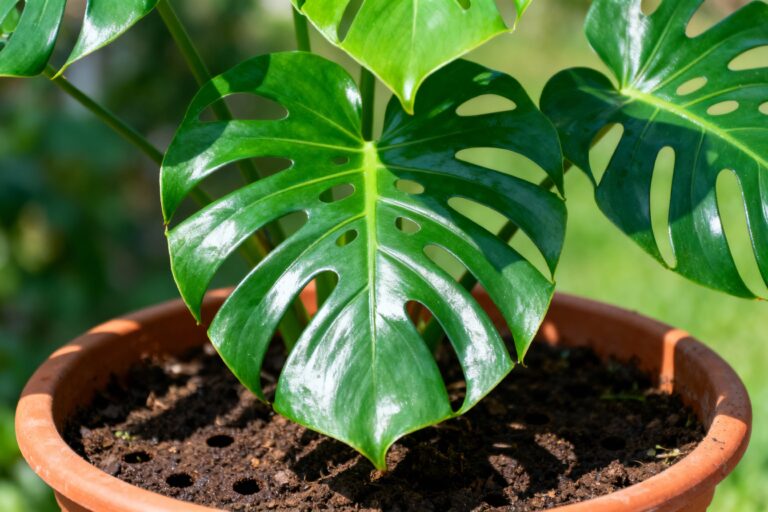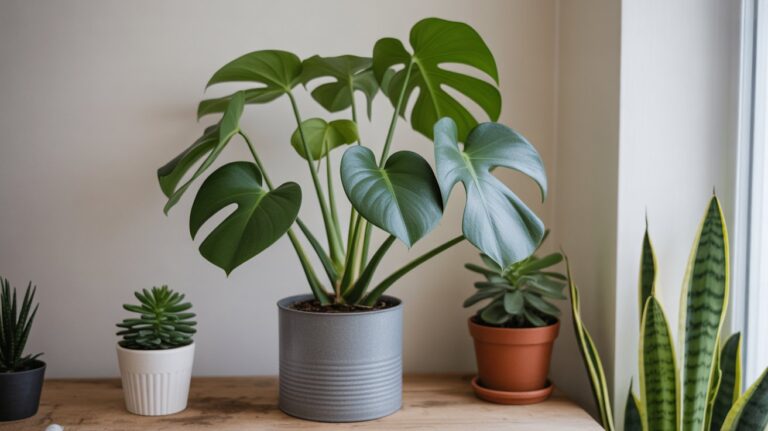Let’s talk Monsteras—the leafy roommate that steals your light and your heart. Those dramatic split leaves? Instant interior swagger.
But style without care turns chic into sad real quick. So let’s marry Monstera care with home decor and make your space (and your plant) thrive together.
Why Monstera Rules the Room
Monstera deliciosa gives big, sculptural energy without trying too hard. It lives for bright rooms, frames furniture like a pro, and turns any corner into a “wow” moment.
You get bold texture, movement, and those iconic splits (fenestrations) that scream, “I drink filtered light and mind my business.” Bonus: Monsteras grow fast in the right conditions. Translation: decor that evolves with your room. And FYI, they photograph like a celebrity—content creators, you’ve met your muse.
Light, Placement, and the Fenestration Glow-Up
Monstera wants bright, indirect light—think near a window with sheer curtains.
Direct sun can scorch leaves, while low light slows growth and fenestrations. If your plant looks like a pancake leaf factory, give it more light.
Room-by-Room Placement Tips
- Living room: Place beside a sofa or console so the leaves frame the seating. It makes the space look intentional and layered.
- Bedroom: Tuck it near a window, not right against it.
Let it trail toward a mirror for extra light bounce and drama.
- Home office: Flank your desk with a mid-sized Monstera. It softens tech-heavy corners and boosts your Zoom backdrop (IMO, essential).
Signs You Nailed the Light
- New leaves with splits = good light and care.
- Leggy stems and tiny leaves = move closer to light or upgrade to a grow light.
- Yellow patches = leaf burn from too much direct sun.
Pots, Stands, and Style That Makes Sense
Your pot choices can level up your decor and your plant’s health. You need drainage first, style second.
The good news? You can have both.
Pot and Stand Combos That Always Work
- Matte ceramic + wood stand: Mid-century friendly and timeless.
- Textured concrete + black metal: Industrial chic, super clean lines.
- Oversized basket cachepot: Hide a plastic nursery pot inside for easy watering and rustic vibes.
Pro tip: Size up only 1–2 inches wider when repotting. Oversized pots hold water like a swamp, and Monsteras do not stan swamp life.
The Care Basics (That Keep Your Leaves Instagram-Ready)
You can’t out-decorate neglect.
Keep this simple routine and your plant won’t bail on you.
Watering
- Water when the top 2–3 inches of soil feel dry. Poke a finger in, don’t guess.
- Thorough soak, then drain completely. Don’t leave it sitting in saucer soup.
- Winter = less water. Growth slows, so your watering can can chill too.
Soil and Feeding
- Use chunky, well-draining mix: potting soil + perlite + orchid bark.
- Fertilize lightly during spring/summer every 4–6 weeks with balanced liquid fertilizer at half strength.
- Repot every 1–2 years when roots circle the pot or poke out the bottom.
Humidity and Temperature
- Humidity sweet spot: 50–60%. Use a tray with pebbles, or group plants for a humidity squad.
- Keep away from drafts and heaters. Monsteras like consistency.
FYI: Wipe leaves monthly with a damp cloth. Dust blocks light and kills the shine.
Train the Drama: Moss Poles, Vines, and Shape
Monsteras are climbers.
Give them support and they’ll reward you with bigger, showier leaves. It’s like plant Pilates—gentle guidance, strong results.
Support Options
- Moss pole: Classic look, helps aerial roots attach. Mist the pole so it stays grippy.
- Coco coir pole: Low maintenance and neat.
- Trellis or wall anchors: For artful, sprawling displays.
Hello, living sculpture.
Shaping for Style
- Rotate weekly for even growth and a balanced silhouette.
- Prune leggy vines to keep your look tidy. Snip above a node for fuller growth.
- Propagate cuttings in water or soil to create a matching mini Monstera for another room.
Styling Moves That Always Look Good
Make your Monstera the star—or the best supporting actor. Either way, let it earn its keep.
Living Room Vibes
- Layer heights: Pair your Monstera with a low coffee table and a tall floor lamp for visual rhythm.
- Balance the corner: Place it opposite a gallery wall to even out weight in the room.
- Echo the shape: Use rounded furniture or arched mirrors to mirror those luscious leaf curves.
Color Palettes
- Warm neutrals: Tan, cream, walnut wood—Monstera pops without screaming.
- Moody hues: Charcoal or deep green walls = botanical lounge vibes.
- Minimal black-and-white: Keep the room crisp so the plant’s texture becomes the feature.
IMO: A Monstera near a mirror gives top-tier drama.
Double the leaves, double the joy.
Varieties and Where They Shine
Different Monsteras bring different energy. Pick the mood, then the plant.
- Monstera deliciosa: Big leaves, classic look. Best for living rooms and entryways.
- Monstera adansonii: Smaller, lacy leaves with holes.
Cute for shelves and hanging planters.
- Monstera ‘Thai Constellation’ or albo variegata: Creamy variegation, high drama. Needs brighter light to keep the white portions happy.
- Monstera pinnatipartita or Peru: Textural, architectural. Great for modern interiors.
Note: Variegated Monsteras grow slower and burn easier.
Give them bright, indirect light and gentle care. No tough love here.
Common Problems (And Stylish Solutions)
Large, glossy leaves highlight any issues—like a spotlight on your mistakes. Don’t panic; fix it and move on.
- Yellow leaves: Usually overwatering.
Check drainage, reduce frequency, and let soil dry more between waterings.
- Brown crispy edges: Low humidity or underwatering. Boost humidity and water deeply.
- No splits in new leaves: Needs more light or support. Move closer to a window and add a pole.
- Droopy leaves: Could be thirsty or waterlogged.
Feel the soil and act accordingly.
- Pests (thrips, spider mites): Wipe leaves, shower the plant, and treat with insecticidal soap or neem. Quarantine if possible.
FAQ
How often should I water my Monstera?
Water when the top 2–3 inches of soil feel dry, then soak thoroughly and let it drain. Frequency changes with seasons and light levels.
In bright summer light, you might water weekly; in winter, every 2–3 weeks works better.
Can I keep a Monstera in low light?
Yes, but it will grow slower and produce fewer splits. If you want dramatic leaves, give it brighter indirect light or add a grow light. Low light equals “cute,” bright light equals “statement piece.”
Do Monsteras need a moss pole?
They don’t need one, but they love it.
A pole supports their climbing habit and encourages larger leaves. If you prefer a sprawling look, let it vine and prune as needed.
Are Monsteras safe for pets?
They are toxic if ingested. Keep them out of nibble range and train pets to ignore them.
If your cat treats plants like salad, consider a pet-safe alternative for low shelves.
Why are my Monstera leaves turning yellow?
Overwatering wins as the usual culprit. Check for soggy soil and poor drainage. If the plant sits wet for too long, roots suffer and leaves yellow from the bottom up.
How do I get bigger leaves and more fenestrations?
Give it bright, indirect light, stable humidity, and a support to climb.
Feed lightly during the growing season. Consistency makes the magic happen.
Conclusion
Your Monstera can double as a design element and a thriving houseplant—if you balance looks with care. Place it where the light flatters, give it a chic pot with real drainage, and train it like the climbing diva it is.
Do that, and you’ll get glossy, split leaves that anchor your room and flex your plant-parent cred. IMO, that’s the best kind of decor: alive, evolving, and a little extra.
